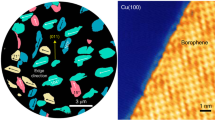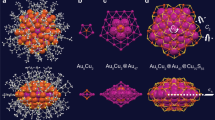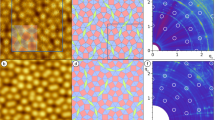Abstract
FOLLOWING the discovery of C60(ref. 1) and the advent of fullerene chemistry, considerable attention has been directed towards the associated cylindrical2,3 and polyhedral4,5 forms of graphite. To date, however, observations of such closed structures have been limited to the carbon system. Here we report the formation of equivalent stable structures in the layered semiconductor tungsten disulphide. After the heating of thin tungsten films in an atmosphere of hydrogen sulphide, transmission electron microscopy reveals a variety of concentric polyhedral and cylindrical structures (ranging in size from <10 to >100 nm) growing from the amorphous tungsten matrix. The closed nature of the structures is verified by electron diffraction and lattice imaging. As with the carbon system, complete closure of the tungsten disulphide layers requires the presence of structural defects (for example, edge dislocations), or the arrangement of atoms in polyhedra other than a planar hexagonal geometry.
This is a preview of subscription content, access via your institution
Access options
Subscribe to this journal
Receive 51 print issues and online access
$199.00 per year
only $3.90 per issue
Buy this article
- Purchase on Springer Link
- Instant access to full article PDF
Prices may be subject to local taxes which are calculated during checkout
Similar content being viewed by others
References
Kroto, H. W., Heath, J. R., O'Brien, Curl, R. F. & Smalley, R. E. Nature 318, 162–163 (1985).
Lijima, S. Nature 354, 56–58 (1991).
Ijima, S., Ichihasi, T. & Ando, Y. Nature 356, 776–778 (1992).
Kroto, H. W. Angew. Chem. Int. Edn Engl. 31, 111–129 (1992).
Ugarte, D. Nature 359, 707–709 (1992).
Bates, T. F., Sand, L. B. & Mink, J. F. Science 111, 512–513 (1950).
Yada, K. Acta cryst. 23, 704–707 (1967).
Iijima, S. J. Cryst. Growth 50, 675–683 (1980).
Bacon, R. J. appl. Phys., 31, 283–290 (1960).
Pauling, L. Proc. Natn. Acad. Sci. U.S.A. 16, 578–582 (1930).
Heidenreich, R. D., Hess, W. M. & Ban, L. L. J. appl. Cryst. 1, 1–19 (1968).
Moser, J., Liao, H. & Lévy, F. J. Phys. D. appl. Phys. 23, 624–626 (1990).
Genut, M., Margulis, L., Hodes, G. & Tenne, R. Thin Solid Films 217, 91–97 (1992).
Aragon de la Cruz, F. & Cowly, J. M. Acta cryst 16, 531–534 (1963).
Bursill, L. A. Int. J. mod. Phys. B4, 2197–2216 (1990).
Powder diffraction file. Card 8–237 (ASTM, Philadelphia, Pennsylvania).
Author information
Authors and Affiliations
Rights and permissions
About this article
Cite this article
Tenne, R., Margulis, L., Genut, M. et al. Polyhedral and cylindrical structures of tungsten disulphide. Nature 360, 444–446 (1992). https://doi.org/10.1038/360444a0
Received:
Accepted:
Issue Date:
DOI: https://doi.org/10.1038/360444a0
This article is cited by
-
The gold ticket to achiral WS2 nanotubes
Nature Materials (2024)
-
Role of active edge sites of atomically thin CVD-grown MoS2 layers on the enhanced visible-light photocatalytic activity
Journal of Materials Science: Materials in Electronics (2024)
-
Synthesis and optical properties of WS2 nanotubes with relatively small diameters
Scientific Reports (2023)
-
MoS2/graphene nanosheet composites prepared by xylitol-assisted ball milling as high-performance anode materials for lithium-ion batteries
Ionics (2023)
-
2D WS2-Based Single-Electrode Triboelectric Nanogenerator for Power Generation and Motion Sensing
Journal of Electronic Materials (2023)
Comments
By submitting a comment you agree to abide by our Terms and Community Guidelines. If you find something abusive or that does not comply with our terms or guidelines please flag it as inappropriate.



